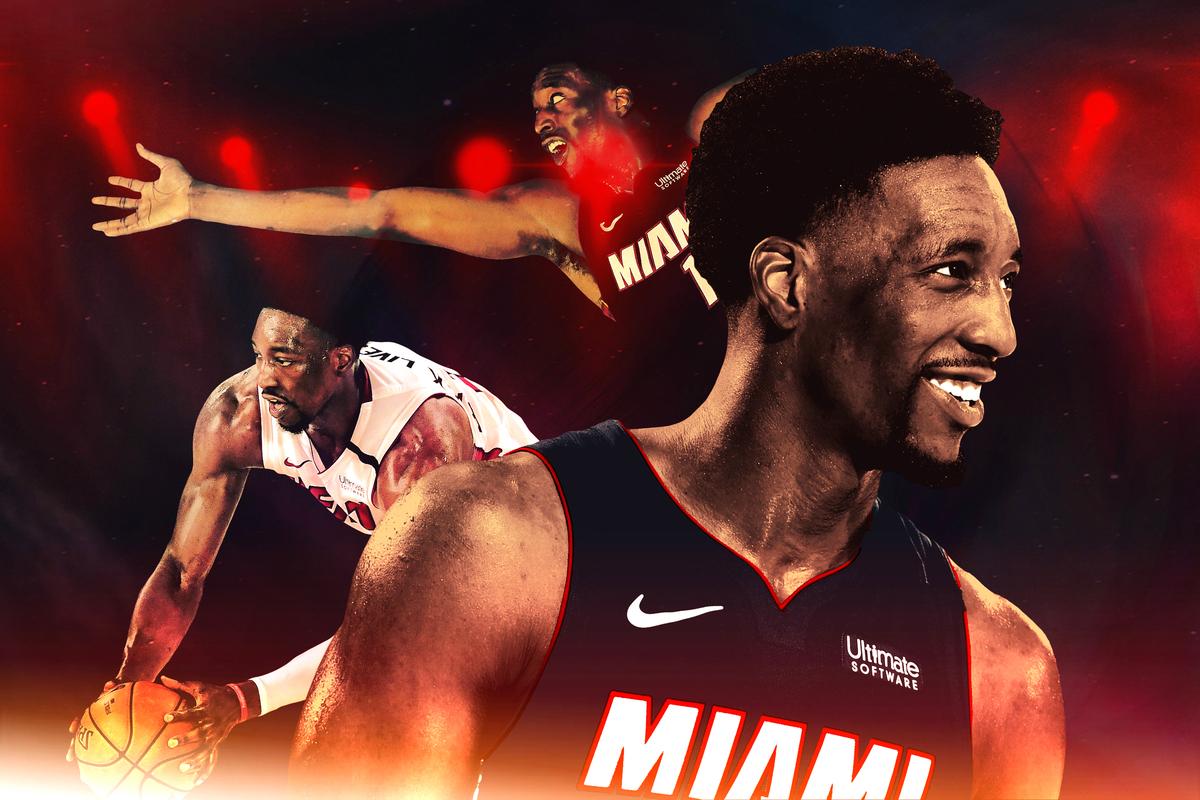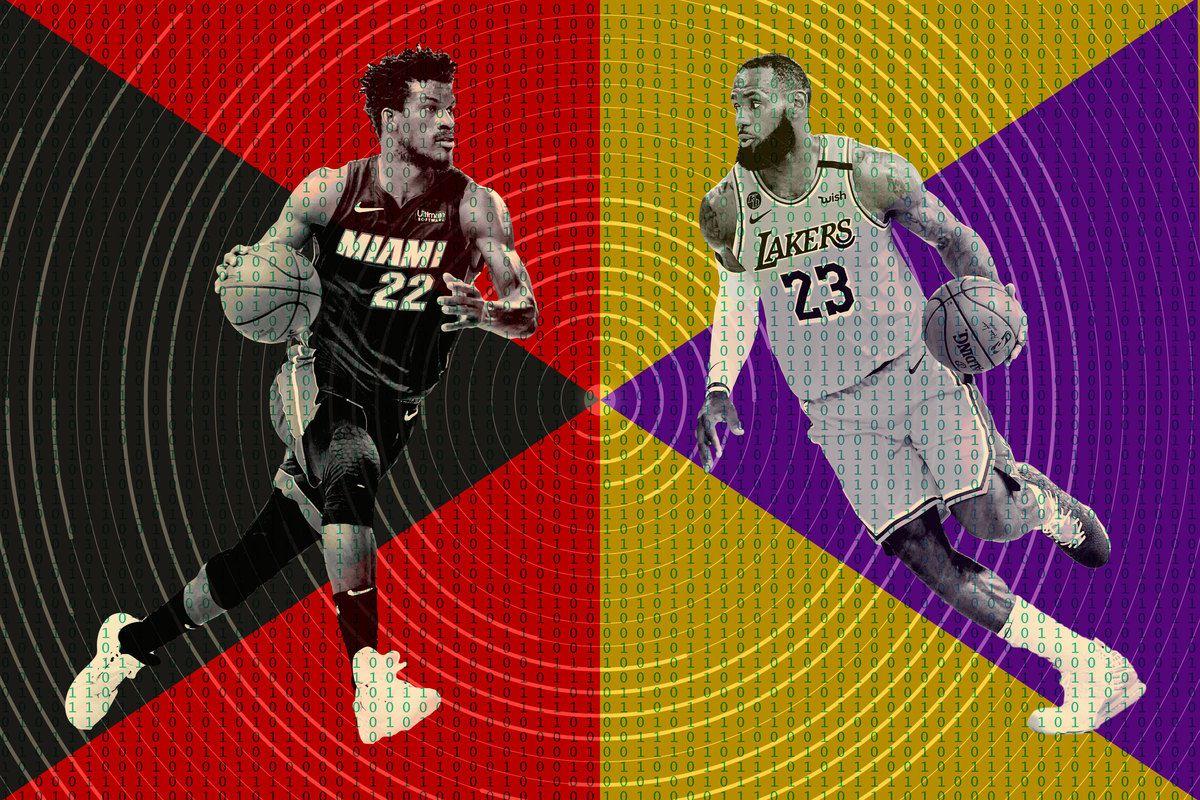
Jayson Tatum came flying down the lane in the final seconds of overtime. With the Heat up two, the Celtics star needed to score to send Game 1 of the Eastern Conference finals into double OT. Tatum leaped into the air for what would have been the dunk of the year. But Bam Adebayo made it the block of the year instead.
Adebayo’s emergence has been one of the keys to Miami’s stunning playoff run. The team’s last-second win over Boston on Tuesday moved it to 9-1 this postseason, including a sweep of a talented Indiana team and a five-game demolition of top-seeded Milwaukee. It all starts with Bam. The Heat’s net rating in the postseason goes from plus-12.9 with him on the floor to minus-5.7 without him. It’s not that he wasn’t a difference-maker during the regular season, when he became an All-Star in his first season as a starter. But a lineup change Erik Spoelstra made before the playoffs began has taken the third-year player’s game to another level.
Bam spent most of the season as a power forward next to either Meyers Leonard or Kelly Olynyk as stretch 5s. But neither center has started a single game in the playoffs. Bam is now the full-time small-ball 5, with Jae Crowder taking Bam’s place as a 3-and-D wing at the 4.
The move has transformed the Heat on both ends of the floor. The defensive benefits are obvious. Instead of protecting a slower center who needs to stay in the paint, they can unleash the 6-foot-9, 255-pound Adebayo and have all five players fly around the floor. Their defensive activity is the closest the team has been to the spirit of the Big Three Heat in a long time. Look at the havoc Bam creates on the possession below. He switches onto Tatum off a down screen, traps Kemba Walker near half court, sprints back to the rim to cut off a drive from Brad Wanamaker, and then rotates to the other side of the paint to cut off a Tatum drive before deflecting his pass and causing a turnover:
He’s not just one of the most versatile defensive big men in the NBA. He’s one of the most versatile defenders, period. Bam can cover the entire spectrum of players, from the biggest to the smallest. He can hold up against Brook Lopez (7 feet and 280 pounds) in the post:
And then turn around and stay in front of Kemba (6 feet and 185 pounds) at the 3-point line:
The toughest types of players to guard in today’s NBA are big wings like Tatum (6-foot-8 and 210 pounds) who can shoot from anywhere and make plays off the dribble. Luckily for the Heat, Bam can handle them, too:
Tatum, who is averaging 25.7 points per game this postseason, can create a mismatch against almost any defender in the NBA. Either he can shoot over the top of smaller ones or get around slower ones. Bam is one of the few players who are just as big and just as fast as him. Adebayo has every tool necessary to play elite one-on-one defense.
Even more impressive is his understanding of the game. Bam is just 23 years old. Most big men his age have no idea how to play team defense. Many never figure it out no matter how long they’re in the league. Bam spent his first two seasons backing up Hassan Whiteside, who mostly used his time on the floor to chase blocks at the expense of sound principles. Bam isn’t just playing defense on an island. He’s protecting his teammates within a complicated scheme that alternates between man and zone.
He was a second-team All-Defensive selection this season. There’s no reason for him not to make the first team every year for the next decade, and annually contend for Defensive Player of the Year honors.
Defense alone would make Bam incredibly valuable. But he’s a great offensive player, too. He’s averaging 16.4 points on 52.7 percent shooting, 11.1 rebounds, and 5.2 assists per game in the playoffs. His ability to lead the break and make plays out of the post is a crucial part of Miami’s unorthodox offense. The Heat were no. 1 in the NBA in the percentage of offense (9.5) off cuts. It’s no surprise when you consider how well their center slings the ball around:
Bam is already in rare company. He’s one of eight players in NBA history to average more than 15 points, 10 rebounds, five assists, one steal, and one block per game in a season, along with Kareem Abdul-Jabbar, Giannis Antetokounmpo, Larry Bird, DeMarcus Cousins, Kevin Garnett, Bill Walton, and Chris Webber.
The closest comparison for him in the modern NBA is Draymond Green. Both players are undersized centers who combine elite playmaking and rebounding with elite post defense, interior defense, and perimeter defense. They have the skill level of a wing on offense, the mobility of one on defense, and the defensive impact of a traditional big man in the paint.
Draymond, like Bam, would move from power forward in the regular season to center in the playoffs. The Warriors didn’t want him to waste his energy banging against bigger players in November and December. So they used players like Zaza Pachulia and Andrew Bogut to soak up minutes and keep him fresh for when it mattered most. Leonard and Olynyk have essentially played the same roles in Miami.
It’s not that Draymond and Bam change their games when they change positions. The shift just allows their teams to put different types of players around them. A player with their skill set is more dangerous next to four guards who can defend multiple positions and make plays on offense. The Lineup of Death wouldn’t be fatal if Draymond weren’t playing at the 5.
Think of it like football. Bam is a quarterback who is now playing with four receivers instead of three. The defense is forced to spread farther out and he now has more targets who can take advantage of any openings that the extra floor spacing creates. Something similar happens on defense. Bam is now the free safety with an extra cornerback around him. He doesn’t have to help a bigger linebacker in coverage. Everyone can guard their man in space, which gives him more freedom to make plays.
There’s a reason that teams with more mobile centers have been so successful in these playoffs. The Pacers (Myles Turner) and Bucks (Lopez) were essentially drawing dead at the position. They started stretch 5s who were at the cutting edge of the league a decade ago. But it’s no longer enough to spread the floor if you can’t guard in space or make plays off the dribble. Bam had a decisive edge against Turner and Lopez anytime that he put the ball on the floor and attacked the basket.
The next question is what will happen when Bam has to face someone like him in the playoffs. He’s not always going to be able to blow by bigger and slower centers. Being able to win as the more skilled and athletic player at the position has never been easier. There will be times when the matchup is flipped, though, and Bam will be the one who has to win with size and strength.
Draymond rarely had that issue. He was one of the prime movers in the small-ball revolution. Most of his opponents tried to beat him with size. They thought they had the Warriors right where they wanted them when it was really just a trap. Golden State always had more difficulty with teams that tried to beat the Warriors at their own game. Houston gave the Warriors much tougher challenges with P.J. Tucker at the 5 in 2018 and 2019 than with Dwight Howard in 2016 and 2017.
This series against the Celtics is Bam’s first taste of those matchups. Boston won its first two series with a smaller and more mobile center in Daniel Theis (6-foot-8 and 245 pounds). Bam should theoretically be able to overpower Theis, but so should Joel Embiid, Marc Gasol, and Serge Ibaka. It’s not quite as easy as Shaquille O’Neal might make it sound on Inside the NBA, especially for a player like Bam. He’s not as comfortable calling his own number. Most of his offense this season came from cuts (23 percent), rolling in the two-man game (17.7 percent), transition (11.2 percent), offensive rebounds (8.5 percent), and spot-ups (8.1 percent).
It was the same story in Game 1. Bam finished with 18 points on 5-of-12 shooting, but his damage came when he was catching dump-off passes in the paint. His attempts to create his own offense weren’t as natural:
Bam doesn’t have a go-to offensive move yet. His biggest problem is his jumper. He’s a career 71.0 percent shooter from the free throw line, indicating that his shot isn’t broken, and his percentage has spiked to 84.2 in the playoffs. Defenders will play off him as much as possible to minimize his advantage in quickness. He would be unstoppable if he could force them to guard him 20-plus feet from the basket.
He will have to become a more creative scorer until then. The good news is that he has shown the ability to score on runners, the other shot that would open up the rest of his game. According to the tracking numbers at Synergy Sports, Bam attempted 73 runners in the regular season and ranked in the 53rd percentile of scorers on those shots. He will always be able to beat defenders to spots on the floor in one or two steps. To take the next step, he just has to make the shots once he gets there:
Bam’s scoring will be more important against Boston than it was against Milwaukee. The Bucks were a rigidly coached team that stubbornly stuck to their defensive scheme even as the Heat shredded it every time down the floor. It won’t be as easy for them against the Celtics, one of the best-coached teams in the league. Brad Stevens has so many versatile perimeter defenders that they should be able to limit penetration and keep the Heat out of their sets as the series goes on. Miami, like Golden State with Draymond, wants Bam to orchestrate a free-flowing offense from the top of the key that creates open 3s for its shooters. Boston should be able to switch any screens, anticipate actions, and force the Heat to play one-on-one. The Celtics don’t have an answer if Bam can attack mismatches both ways. But that’s an awfully big if. The Heat have to feel good about their ability to win as the smaller team after what happened in their first two series. The problem is that dynamic is as much a function of the other team’s choices as their own. The only thing stopping Milwaukee from downsizing and playing Giannis Antetokounmpo at the 5 was its coach. Miami’s advantages in speed and skill at the position would have gone away in a snap.
That’s what happened to Boston in its second-round series against Toronto. The Raptors almost came back after benching Gasol and Ibaka in the fourth quarter and playing O.G. Anunoby (6-foot-7 and 233 pounds) as a small-ball 5. Anunoby is bigger than Draymond and just as athletic as Bam. Changing positions makes him a much more valuable player because he goes from a not particularly skilled wing to a skilled center who stretches the floor better than either Gasol or Ibaka.
Players like Bam are making traditional big men obsolete. But the days when they can roam free and exploit those types of players are numbered. They will eventually have to start beating players who play like them. The next step in the evolution of the position is finding a center who can defend, pass, and score like a guard. Bam will have to add the latter skill to his game to keep up.


